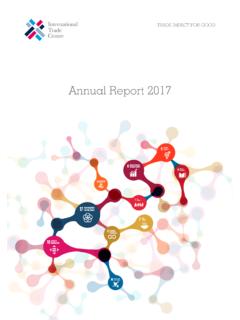Transcription of Opportunities and Challenges for Telemedicine
1 Opportunities and Challenges for Telemedicine The shortage of specialists, intensivists, and on-call movement to approximately $30,000 today, those capital physicians, as well as advances in technology, are requirements may still be cost prohibitive for some driving the growth of Telemedicine in the delivery of providers, particularly those in rural areas, who stand to healthcare across the Telemedicine refers to the benefit most from the use of transfer of medical information via electronic Regulatory concerns, including licensing issues and communication from one location to another to enhance accreditation requirements, also present obstacles to the quality and efficiency of patient comfort and Telemedicine implementation.
2 Depending on state The utilization of communication equipment to link licensing rules, practitioners utilizing interstate healthcare practitioners and patients in different Telemedicine may have to obtain licenses in each state locations will likely help to achieve many of the where they treat patients. However, licensure laws healthcare reform goals, including: increasing cost generally have some exceptions for providing interstate efficiency; improving patient access to specialists Telemedicine without multiple state licenses such as (especially in physician shortage areas); and, enhancing reciprocal licensure, which allows for a mutual communication among exchange of privileges between states. 8 Additional The federal government has predicted a healthcare regulatory concerns arise as Telemedicine falls under the provider shortage of approximately 24,000 physicians scope of the Joint Commission's accreditation standards and nearly one million nurses by 2020, which is a and the Centers for Medicare and Medicaid Services concern that may be lessened through the (CMS)
3 Credentialing implementation of Through Telemedicine , Additionally, there is significant disagreement companies such as Night Hospitalist Company, LLC, surrounding the determination as to which practitioners expand access to physicians and nurses within a should be reimbursed for Telemedicine services as well shortage area by providing telephonic medical care to as what method of reimbursement is appropriate. While hospitals with ongoing staffing shortages and diagnostic 11 states have implemented legislation mandating some screening via webcams and instant message to virtual level of private payor Telemedicine reimbursement, the These services allow healthcare professionals to mandates are inconsistent and often misunderstood.
4 Adequately care for individuals even though the provider State reimbursement policies vary in the percent of may not be physically present. Telemedicine also allows technological overhead reimbursed and whether the hospitals to expand their market service area by practitioner or healthcare entity is reimbursed for the connecting hospital employed physicians to populations healthcare service rendered. Significantly, 32 state outside the hospital's main service area via technology Medicare pilot programs include some form of at outlying medical clinics and Implementing Telemedicine Telemedicine technology in outlying clinics has the following benefits: (1) keeps healthcare spending within Lack of uniformity, underscored by the range of a local community; (2) lowers patient travel for reimbursement and licensure policies currently in place, healthcare services; (3) aids community development; has kept Telemedicine from gaining widespread (4) provides community benefit; and, (5) increases acceptance.
5 This lack of standardization may mitigate community the effect of evidence-based medicine's ability to drive funding and implementation. To overcome this barrier, Despite the potential benefits of Telemedicine , several leaders at Loyola University suggest healthcare entities barriers to the uniform implementation of Telemedicine perform a needs based assessment in addition to a cost across the healthcare industry exist, cost, regulatory benefit analysis of acquiring Telemedicine as a way to concerns, reimbursement issues, and lack of better predict Despite these and other standardization. As with any form of technology, barriers, approximately 200 Telemedicine networks Telemedicine entails significant capital formation and currently exist in the , connecting over 3,000.
6 Operating expenses. While the price tag for a complete medical and healthcare institutions throughout the in-hospital Telemedicine studio has decreased from Particularly in the wake of healthcare reform, $200,000 at the beginning stages of the Telemedicine HEALTH CAPITAL CONSULTANTS (Continued on next page). (Continued from previous page). experts encourage health entities to withstand and adapt 6. Benefits of Telemedicine Telemedicine Association of Oregon, January 16, 20-4, Accessed at to various barriers and implement Telemedicine , p. 2-4. programs now or risk losing market share in the 7. "Does E-Health Stand A Remote Chance" By Gienna Shaw, 1. " Telemedicine Defined" American Telemedicine Association, HealthLeaders, February 2011, 2011, 8.
7 Interstate Licensure of Telemedicine Practitioners By Glenn cfm?pageid=3333 (Accessed 2/18/11). W. Wachter, Telemedicine Information Exchange, November 15, 2. "Does E-Health Stand A Remote Chance" By Gienna Shaw, 2006. 9. HealthLeaders, February 2011, ; "National Telemedicine "JCAHO Published New Hospital Credentialing Standards for Inititives: Esseantial to Healthcare Reform" By Rashid L. Telemedicine " Mondaq Business Briefing, Nov. 5 2003, Bashshur and Gary W. Shannon, Telemedicine and E-Health, Vol. 15, No. 6, July/August 2009, p. 601. 71648 (Accessed 7/1/09). 10. 3. What Works: Healing the Healthcare Staffing Shortage "Does E-Health Stand A Remote Chance" By Gienna Shaw, PricewaterhouseCoopers' By Health Research Institute, 2007, HealthLeaders, February 2011, 11.
8 "Does E-Health Stand A Remote Chance" By Gienna Shaw, 4. "Who are We?" Night Hospitalist Company, LLC, HealthLeaders, February 2011, . (Accessed 12. What is Telemedicine and Telehealth? American Telemedicine 2/21/11). Association, 5. Night-Shift Solutions By Lisa Ryan, The Hospitalist, April 2009, (Accessed 2/21/11). 13. "Does E-Health Stand A Remote Chance" By Gienna Shaw, (Accessed 6/20/09). HealthLeaders, February 2011, HEALTH CAPITAL CONSULTANTS (Continued on next page). Robert James Cimasi, MHA, ASA, FRICS, MCBA, AVA, CM&AA, serves as President of HEALTH CAPITAL CONSULTANTS (HCC), a nationally recognized healthcare financial and economic consulting firm headquartered in St. Louis, MO, serving clients in 49 states since 1993.
9 Mr. Cimasi has over thirty years of experience in serving clients, with a professional focus on the financial and economic aspects of healthcare service sector entities including: valuation consulting and capital formation services; healthcare industry transactions including joint ventures, mergers, acquisitions, and divestitures;. litigation support & expert testimony; and, certificate-of-need and other regulatory and policy planning consulting. Mr. Cimasi holds a Masters in Health Administration from the University of Maryland, as well as several professional designations: Accredited Senior Appraiser (ASA American Society of Appraisers); Fellow Royal Intuition of Chartered Surveyors (FRICS Royal Institute of Chartered Surveyors); Master Certified Business Appraiser (MCBA Institute of Business Appraisers).
10 Accredited Valuation Analyst (AVA National Association of Certified Valuators and Analysts); and, Certified Merger & Acquisition Advisor (CM&AA Alliance of Merger & Acquisition Advisors). He has served as an expert witness on cases in numerous courts, and has provided testimony before federal and state legislative committees. He is a nationally known speaker on healthcare industry topics, the author of several books, the latest of which include: The Healthcare Certificate of Need HCC Home Sourcebook [2005 - Beard Books], An Exciting Insight into the Healthcare Industry and Medical Firm Profile Practice Valuation [2002 AICPA], and A Guide to Consulting Services for Emerging Healthcare Organizations [1999 John Wiley and Sons].






